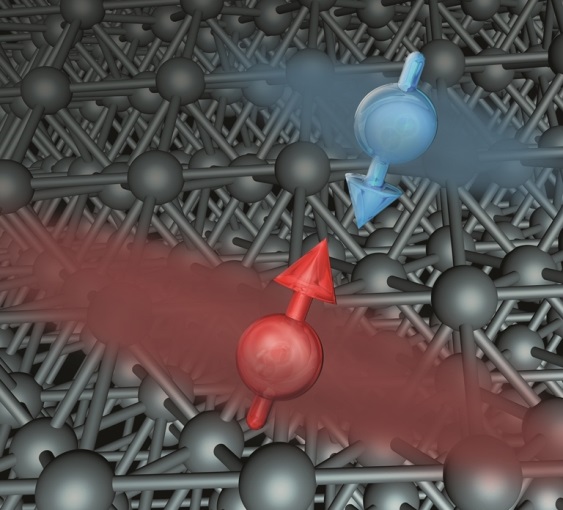
Spin-Controlled Electrical Conduction: A Breakthrough in Metals

Difference in conduction by electrons with opposite spins in ferromagnetic metals can be precisely resolved using terahertz waves.
© MPI-P
Modern magnetic memories, such as hard drives installed in almost every computer, can store a very large amount of information thanks to very tiny, nanoscale magnetic sensors used for memory readout. The operation of these magnetic sensors, called the spin-valves, is based on the effect of giant magnetoresistance (GMR), for which its inventors Albert Fert and Peter Grünberg were awarded a Nobel Prize in Physics in 2007.
The GMR effect is based on the idea of electrical conduction in ferromagnetic metals, proposed by Sir Nevill F. Mott as early as in 1936. In Mott’s picture, the conduction electrons in ferromagnetic metals experience scattering depending on their microscopic magnetic moment – the spin.
That is, the electrons with one spin orientation scatter less and are therefore more conductive than the electrons with the opposite spin orientation. This spin-asymmetry in electron conduction is greatly amplified when the thin films of ferromagnetic and nonmagnetic metals are combined together to form a spin-valve in which electrical resistivity becomes very sensitive to the magnetic field, leading to a GMR effect.
Even though the Mott spin-dependent conductivity is at the heart of magnetic memories and many other technologies, its direct observation has been a long time challenge. Indeed the fundamental parameters of Mott conduction – spin-dependent electron scattering time and spin-dependent electron density – can be directly and unambiguously determined only if the conductivity of the metal is measured on the same ultrafast timescale at which the electron scattering occurs, that is sub-100 femtosecond (1 fs = 10-15 s, i.e. one millionth of one billionth of a second). For many decades, such an extremely fast timescale of experimental measurement precluded the observation of magnetotransport in metals on the fundamental level.
In a collaborative work carried out by the research groups at the Max Planck Institute for Polymer Research (MPI-P) and the Johannes Gutenberg University (JGU), with the contribution of Sensitec GmbH and the Fritz Haber Institute of the Max Planck Society, the scientists managed to break the speed barrier for fundamental magnetotransport measurements by using a method called ultrafast terahertz spectroscopy (1 THz = 1012 Hz, i.e. one thousand billion oscillations per second).
“By studying the interaction of THz electromagnetic waves – which oscillate about as fast as the electrons in metal scatter their momentum – with a spin-valve, we could directly measure for the first time the fundamental parameters of Mott conduction”, explains Dmitry Turchinovich, project leader at the MPI-P. “In particular, we found that the traditional measurements performed on the slower timescales significantly underestimate the spin-asymmetry in electron scattering which is responsible for the magnetic sensor operation”.
The results of the research team: Zuanming Jin, Alexander Tkach, Frederick Casper, Victor Spetter, Hubert Grimm, Andy Thomas, Tobias Kampfrath, and Mischa Bonn, led by Dmitry Turchinovich (MPI-P) and Mathias Kläui (JGU) have recently been published in Nature Physics.
This work adds a new and powerful tool, ultrafast THz spectroscopy, to the studies in spintronics, opening up a new research field – terahertz spintronics.
http://mainz-thz-group.weebly.com/– Information about Prof. Turchinovich and his research
http://www.mpip-mainz.mpg.de/home/en – Max Planck Institute for Polymer Research















